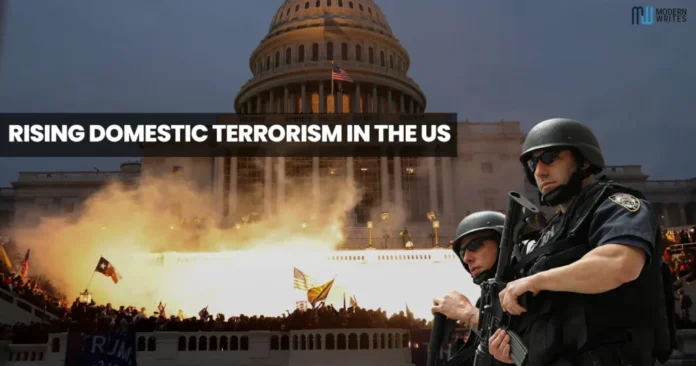Introduction of Rising Domestic Terrorism in the US
The proportion of domestic terrorist assaults and attempts has increased over the past two years. Political polarization, COVID-19 mandates, racial inequality, elections, and other variables contribute to the rise in rallies and counter-protests in many U.S. urban areas. There has been a rise in extremism, violent speech, and violence in metropolitan regions of the United States as ideologically opposed people and groups organize against each other. Due to the rising levels of violence, this situation can also be viewed as a “security dilemma,” in which one side’s attempts to strengthen its own safety, generally through the use of firearms, melee weapons, or incendiaries, worsens the safety of others. Rising Domestic Terrorism in the US
This has caused a dramatic reversal inside the lengthy-term trend of reducing levels of violence between radicals in primary U.S. Towns. More than half of all home terrorist assaults in 2021 occurred for the duration of or immediately after big-scale demonstrations in foremost cities. And on the grounds that domestic terrorist acts are getting more and more commonplace, it is no marvel that the management, navy, and law enforcement establishments are the principle sufferers. Rising Domestic Terrorism in the US
Rising Tide of Domestic Terrorism in the US
U.S. Home terrorism is described via 18 United States of America 2331(5) which says, “the “time period home terrorism” approach sports that (a) involve acts risky to life in violation of the criminal laws of the United States or any country; (b) appear like intentional to intimidate or coerce a civilian populace; to persuade the policy of a government by way of intimidation or to affect the conduct of a government the usage of mass destruction, assassination, or kidnapping; and arise mainly in the united states.”
CSIS has constructed a database of 1,040 terrorist assaults and plots in the US between January 1, 1994, and December 31, 2021, in an try to study more about the styles of domestic terrorism in the united states. Figure 1 depicts an increase in mortality from 2020 (5 deaths) to 2021 (30 deaths). There were about 35 people killed by terrorist acts in the United States in 2019, so this number is basically on par with that.
Terrorist attacks inside the U.S. Rose dramatically in 2020 and 2021, especially in important city regions. Predictions indicate that terrorist attacks and plans in the United States of America will increase from 2% in 2019 to 47% in 2020 and 53% in 2021, with the majority occurring at rallies. This has caused certain American cities like Portland, Seattle, Big Apple, Los Angeles, and Washington, D.C., to become hotspots for home terrorism, with extremists from exceptional companies dealing with one another and in opposition to regulation enforcement government. As a result, urban regions now face a “security conundrum,” in which heightened security measures taken by one group pose a threat to those taken by another, fueling tensions on both sides.
Data compiled by the CSIS Transnational Threats Project
There was no clear pattern in the motivations of domestic terrorists, but assaults against the administration, army, and law enforcement institutions and employees were the most prevalent. Twenty-nine of the 77 terrorist acts and conspiracies in 2021 had been aimed toward civilian, navy, or security establishments. Rising Domestic Terrorism in the US
The culprits in the query claimed allegiance to diverse anti-government and anti-authority ideals and establishments, including QAnon, the sovereign citizen organization, militant agencies, anarchism, anti-fascism, environmentalism, and others. Next to homes, businesses were the primary target of anarchists, antifascists, and similar extremists who resorted to violence.
White nationalists and those with similar ideologies have often directed their hatred toward individuals of minority businesses, immigrants, Muslims, and Jews specifically. Example: In 2022, Malik Faisal Akram planned to attack a synagogue in the fortress well worth, Texas, location. On the Tree of Lifestyles synagogue in Pittsburgh, Pennsylvania, in 2018, Robert Bowers killed eleven human beings. In recent years, there has been a recurrent sample of attacks in opposition to immigrants. Rising Domestic Terrorism in the US
An exam of CSIS files famous that there were 15 instances linked to immigrants that have led to 27 deaths and hundreds of accidents considering 2015. A mass taking pictures at a Walmart on August three, 2019, by means of a man named Patrick Crusius who, in keeping with officials, had written a manifesto denouncing the “Hispanic invasion” of Texas, turned into one of the attacks that won huge word. Twenty-three men and women have been killed and some other dozen were injured inside the shootings; 8 of the sufferers were Mexican nationals. Rising Domestic Terrorism in the US
Biden Administration Policies Rising Domestic Terrorism in the US
An intelligence file supplied to Congress by the Biden government highlighted the increasing chance posed by white supremacists and militias, highlighting the severity of the need for added price range to combat the unfolding of indigenous radicalism in the U.S.A. The intelligence file singled out the risk posed through militias, claiming that it’ll boom over the subsequent months because of “arguable sociopolitical variables.” This turned into nearly definitely a connection with the aftermath of the seasoned Trump mob’s violence within the Capitol on January 6. Rising Domestic Terrorism in the US
The survey observed that white supremacists and other racially charged violent extremists had been more likely to perform operations with excessive civilian casualties, while militias tended to consciousness on police and authorities institutions. It claimed that lone perpetrators or small organizations of extremists had been more likely than larger corporations to perform assaults. Rising Domestic Terrorism in the US
The Biden administration has placed a high priority on combating acts of domestic terrorism. Similar to the hazard assessment, the government is exploring strategies with the police and intelligence community to prevent domestic terrorist attacks. Following a raid at three spas in the Atlanta region the previous day, which resulted in the deaths of eight individuals, including six Asian women, the government released the document.
Soon after he assumed fee, President Biden demanded a complete hazard analysis in the aftermath of the January 6 assault on the Capitol, which uncovered the corrosive domestic extremism that has rattled the country. Congress and the White House received a secret copy, and the public received the concise executive summary. The summary report was consistent with previous studies by the FBI and DHS that warned of the growing threat of domestic terrorism, especially after supporters of President Donald J. Trump accepted his bogus statements of election rigging. Rising Domestic Terrorism in the US
Groups Involved in Domestic Terrorism
In 2021, there was an uptick in the number of assaults and plans orchestrated by anarchists, anti-fascists, and other like-minded radicalists. White supremacists, anti-government militias, and radicals with similar interests carried out the majority of incidents and conspiracies in 2021 (49%) while anarchists, anti-fascists, and radicals with similar interests increased the proportion of assaults and attempts from 23% in 2020 to 40% in 2021. Along with this surge, protest aggression has also increased. At the same time 2021 noticed a report variety of terrorist attacks from both the ways right and the long way left, the far rights were notably more likely to be lethal, both with appreciation to the weapons used and the number of people killed. Rising Domestic Terrorism in the US
Terrorist moves in 2021 may also shed mild at the motivations and capacity severity of the threat they pose based totally at the weapons and places they hire. Extremists of the white nationalist variety and their allies employed more violent means of attack, including firearms. Attacks were mostly nonlethal, with melee attacks being a common tactic among anarchists, anti-fascists, and other radicals. Regardless of the ideology of the terrorists responsible, weapons were the leading cause of death in the eleven assaults that resulted in fatalities in 2021. Rising Domestic Terrorism in the US
Combating Domestic Terrorism
After a 100-day study of federal responses to internal radicalism, which President Biden initiated in January, the Biden regime unveiled the first-ever National Strategy for Countering Domestic Terrorism on June 15, 2021. While law enforcement at all levels of government retains their constitutional authority to investigate and destroy terrorist activity independently, the National Strategy for Countering Domestic Terrorism strives to enhance cross-agency cooperation and coordination at the policy level.
The statement calls for a new, wider method for addressing the fundamental reasons for violence among local people and online while reiterating a number of measures that have been cornerstones of USA counterterrorism attempts since September 11, 2001. The most novel, and maybe most divisive, part of the approach is its emphasis on addressing “long-term causes of domestic terrorism.” Although previous Trump administration counterterrorism policies touched on these topics, this report is the first of its kind to clearly link USA counterterrorism activities to broader social concerns, such as systematic racism, criminal justice reform, and gun regulation.
Obama Rising Domestic Terrorism in the US
The development and implementation of terror prevention strategies in this paper marks a significant shift from previous USA administrations’ combating violent extremism (CVE) initiatives. During the Obama administration, Arab and Muslim groups heavily criticized traditional CVE techniques that focused on opposing Salafi-jihadist theology within societies. Therefore, the new strategy proposes a public health-centered approach to violence prevention. Rising Domestic Terrorism in the US
This will broaden the initiatives to address the reasons for politically-motivated violence, strengthen individual and societal resistance to extremist ideology, and create pathways away from extremism by including state and local collaborators, NGOs, and nontraditional US government entities like the Departments of Health and Human Services, Education, and Veterans Affairs. Rising Domestic Terrorism in the US
The Department of Homeland Security has implemented counter-terrorism policies that focus on stopping terrorist attacks at home as well. Among the topics covered in the DHS’s internal evaluation of 2020 and subsequent strategy and execution roadmap for domestic terrorism were the following.
The branch of place of origin security’s Strategic Framework for Countering Terrorism and focused Violence Rising Domestic Terrorism in the US
Illustrates the department’s strategy to cope with and counteract terrorism and other varieties of violent incidents, with the subsequent four targets in thought: thwart terrorists and different violent players from infiltrating the United States and gaining access to the United States’ trade, immigration, and home and overseas transit mechanisms; recognize the converting nature of the terrorist and directed violence risk panorama and proportion this knowledge with collaborators within the fatherland protection agency; growth the protection of united states of America structure and the contingency planning of its citizens. Rising Domestic Terrorism in the US
Implementation Plan for the Strategic Framework for Countering Terrorism and Targeted Violence Rising Domestic Terrorism in the US
Consistent with the overarching strategic framework, this plan details how the department plans to put its distinctive design to use in creating and improving its arsenal against terrorism. The plan outlines 539 key actions over a four-year period that are necessary to achieve the intended outcomes of the Strategic Framework. Rising Domestic Terrorism in the US





